15 Best Performance Management Tools in 2025
Did you know that only 10% of U.S. workers feel
Did you know that only 10% of U.S. workers feel engaged after receiving negative feedback? That eye-opening stat from Gallup sheds light on a serious flaw in traditional performance reviews. It’s pretty alarming—almost 30% of employees get so discouraged by negative feedback that they start searching for new jobs. Clearly, the traditional methods just aren’t cutting it anymore.
In fact, a study by Workhuman found that over half of employees (55%) feel that annual reviews do very little to help them grow. As the workplace changes at lightning speed, we need to adapt our approach to managing our teams.
That’s exactly why performance management tools have become essential in today’s dynamic business landscape. For startups and growing businesses, these tools aren’t just helpful—they’re a strategic game-changer. By aligning individual goals with company objectives, enabling real-time feedback, and supporting continuous development, these tools help build a resilient, high-performing workforce.
Thanks to advances in technology, we now have access to a wide range of performance management tools designed to streamline the process. Whether it’s tracking goals, conducting performance evaluations, or supporting employee growth, these tools offer powerful features that cater to various organizational needs.
In this guide, we’ll explore 15 of the most innovative performance management tools that are set to transform the way businesses manage and elevate employee performance in 2025 and beyond. From intuitive goal-setting frameworks to feedback-rich environments, these tools drive transparency, accountability, and continuous improvement—giving your business the edge it needs to thrive.
Efficient performance management tools are essential for aligning goals, tracking progress, and enhancing employee engagement. Here’s a quick look at some of the top solutions available, with key features and pricing.
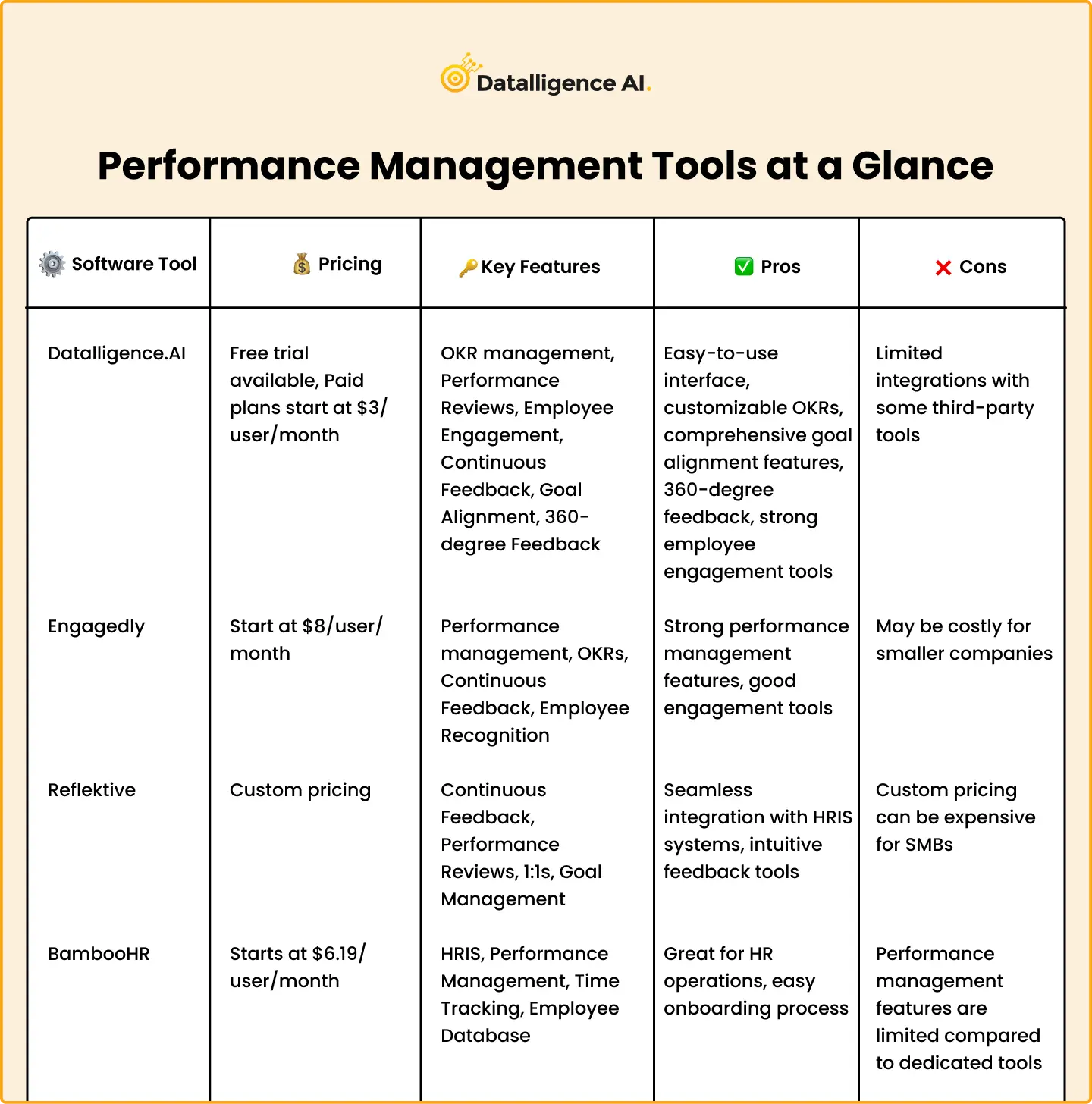
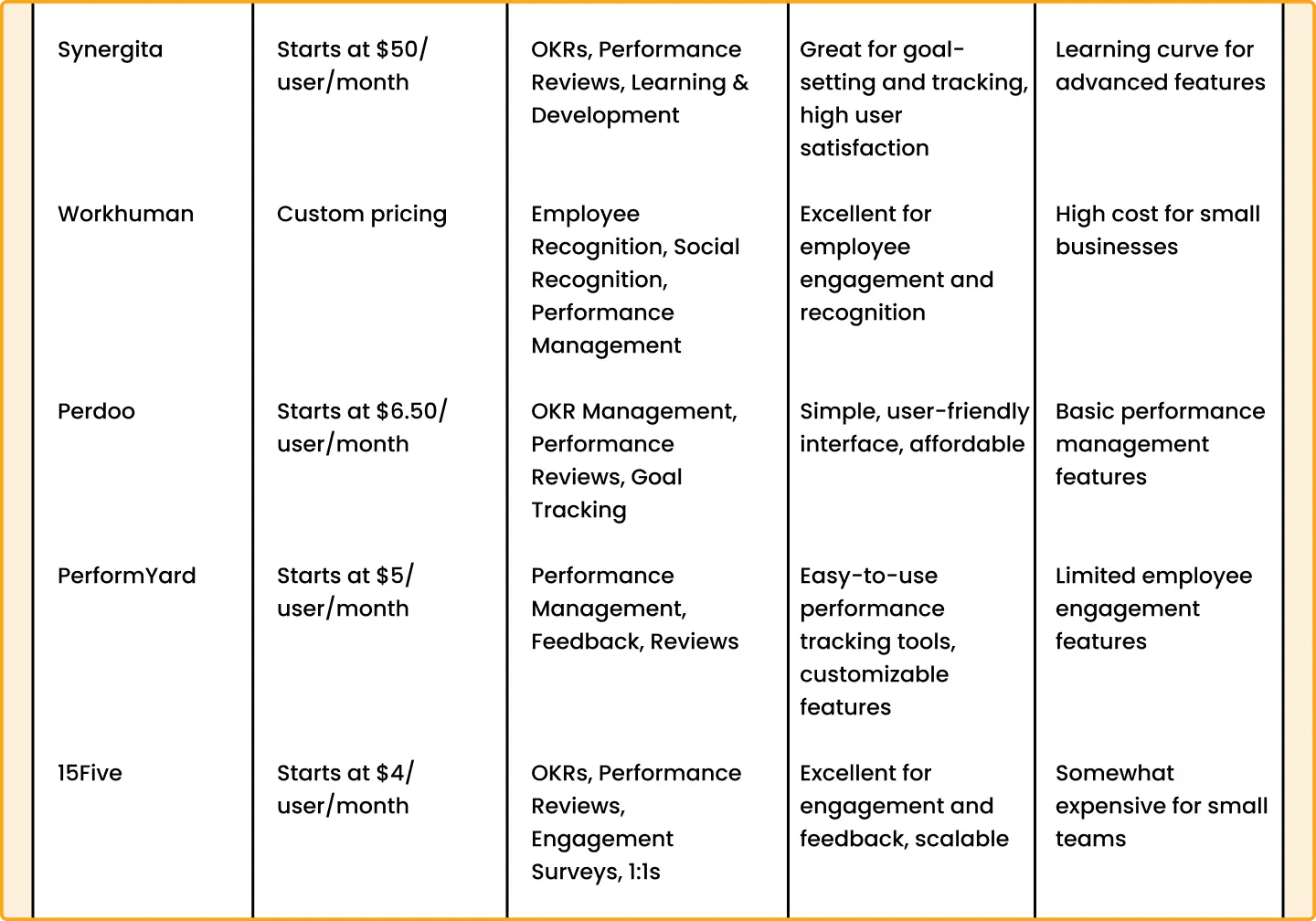

Without further ado, let’s delve into the realm of the 15 best performance management tools, and software for 2024, each offering a distinct value proposition and a powerful set of features designed to elevate your organization’s performance management practices to new heights.
In the realm of performance management software tools, Datalligence stands out as a comprehensive and user-friendly platform designed to enhance organizational productivity and employee engagement. With its impressive array of features, Datalligence is poised to revolutionize the way organizations approach performance management in 2025.
Datalligence gives organizations the tools they need to set and manage their goals effectively by using the SMART framework—Specific, Measurable, Achievable, Relevant, and Time-bound. This method ensures that goals are not only clear but also quantifiable and in line with the company’s overall strategy. By breaking down objectives into specific criteria, like measurable outcomes and realistic timelines,
Datalligence enables teams to concentrate their efforts and monitor their progress more efficiently.This goal management feature promotes accountability, transparency, and strategic alignment across different levels of the organization.
One of Datalligence’s core strengths is its ability to facilitate real-time feedback and performance reviews between managers and employees. This feature encourages continuous improvement by providing timely insights into individual and team performance. Managers can deliver constructive feedback promptly, fostering a culture of openness and growth within the organization.
Real-time performance reviews also enable agile adjustments and goal revisions, ensuring that employees stay on track and aligned with organizational objectives.
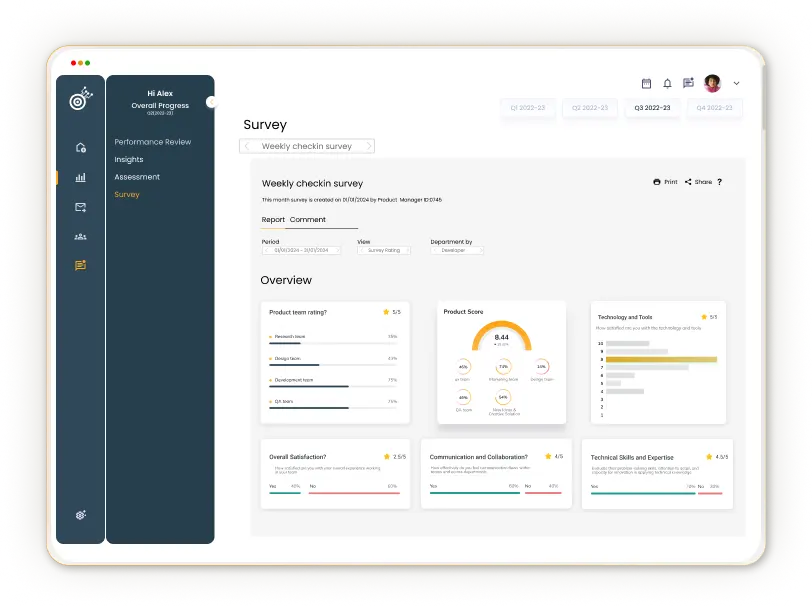
Datalligence includes robust employee engagement survey tools that enable organizations to gather valuable feedback and insights from their workforce. These surveys are essential for gauging employee satisfaction, identifying areas for improvement, and understanding overall sentiment within the organization.
By leveraging employee feedback through regular surveys, Datalligence helps organizations make informed decisions to enhance workplace culture, address concerns, and boost employee morale. This engagement-focused approach contributes to higher retention rates and increased productivity.

Datalligence offers seamless integration with HRIS (Human Resource Information System) systems and provides pre-built dashboards for easy data visualization and analysis. This integration streamlines processes by centralizing employee data and performance metrics within a single platform.
The pre-built dashboards offer valuable insights into key performance indicators (KPIs), goal progress, and employee engagement metrics. This integration simplifies reporting and enhances decision-making, allowing organizations to leverage data-driven insights for strategic planning and resource allocation.
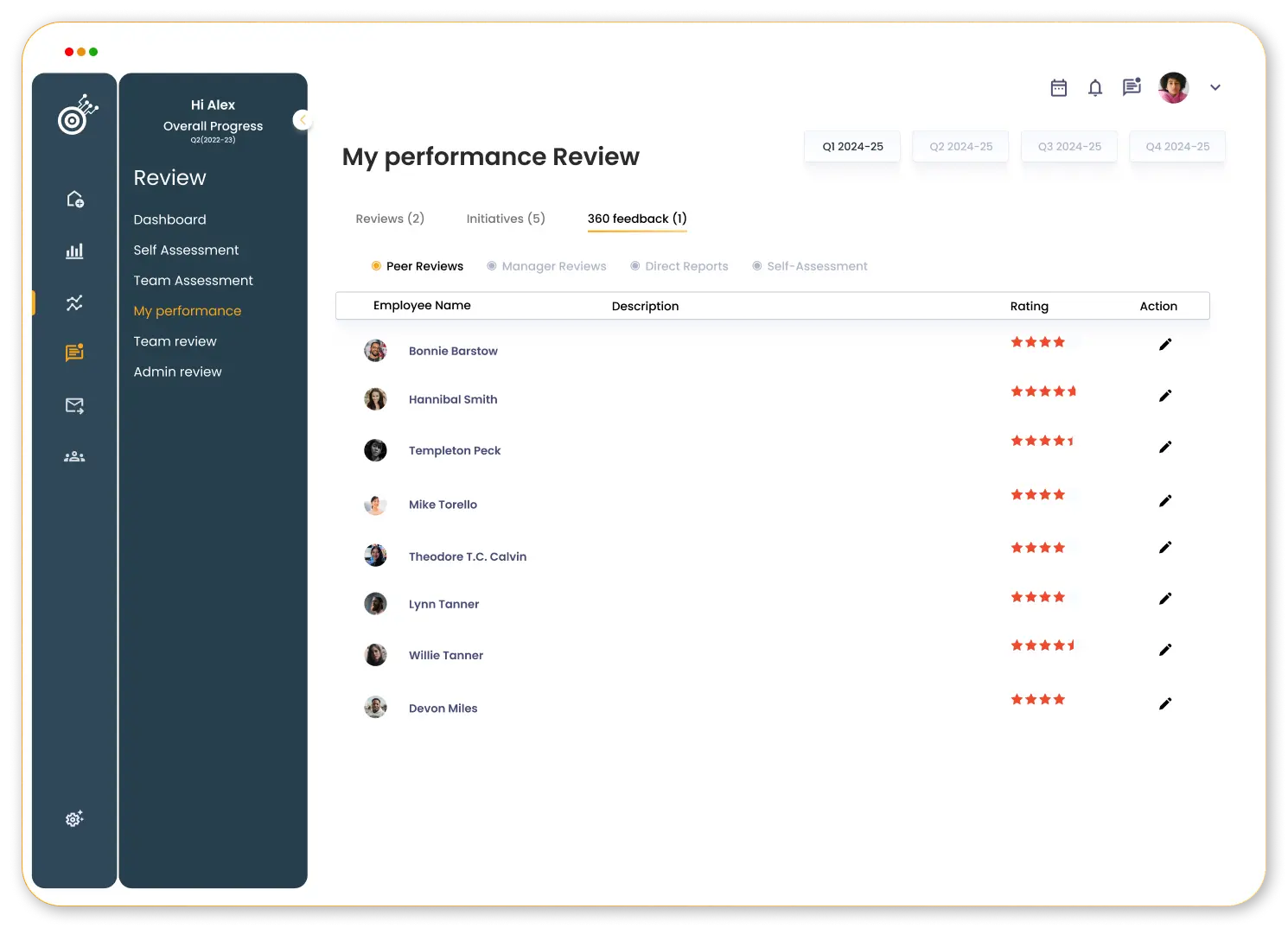
Datalligence facilitates comprehensive performance reviews and supports the implementation of the Objectives and Key Results (OKRs) methodology.
This feature enables organizations to conduct structured evaluations, assess individual and team performance against defined goals, and identify areas for improvement.
By aligning performance reviews with OKRs, Datalligence promotes goal transparency and accountability, driving continuous improvement and strategic alignment across the organization. This structured approach to performance management empowers teams to achieve measurable outcomes and contribute effectively to organizational success.
G2 Review about Datalligence
Pricing of Datalligence
Starter : Free 14 days trial
Goals & OKRs : $4 per month/user/Billed Annually
Most popular – Performance $6 : per month/user/Billed Annually
Enterprise : Contact us our Sales team
Engagedly is a versatile employee management platform designed to execute performance management techniques, enable development and growth, and engage employees in processes. The platform offers various features, including employee engagement surveys, rewards and badges, real-time and 360-degree feedback, mentoring resources, performance reviews, and competency assessments. Engagedly ensures real-time access and collaboration through its mobile-enabled interface.
Engagedly pricing starts from $2 per month/user and for more information visit their website or Contact their sales team.
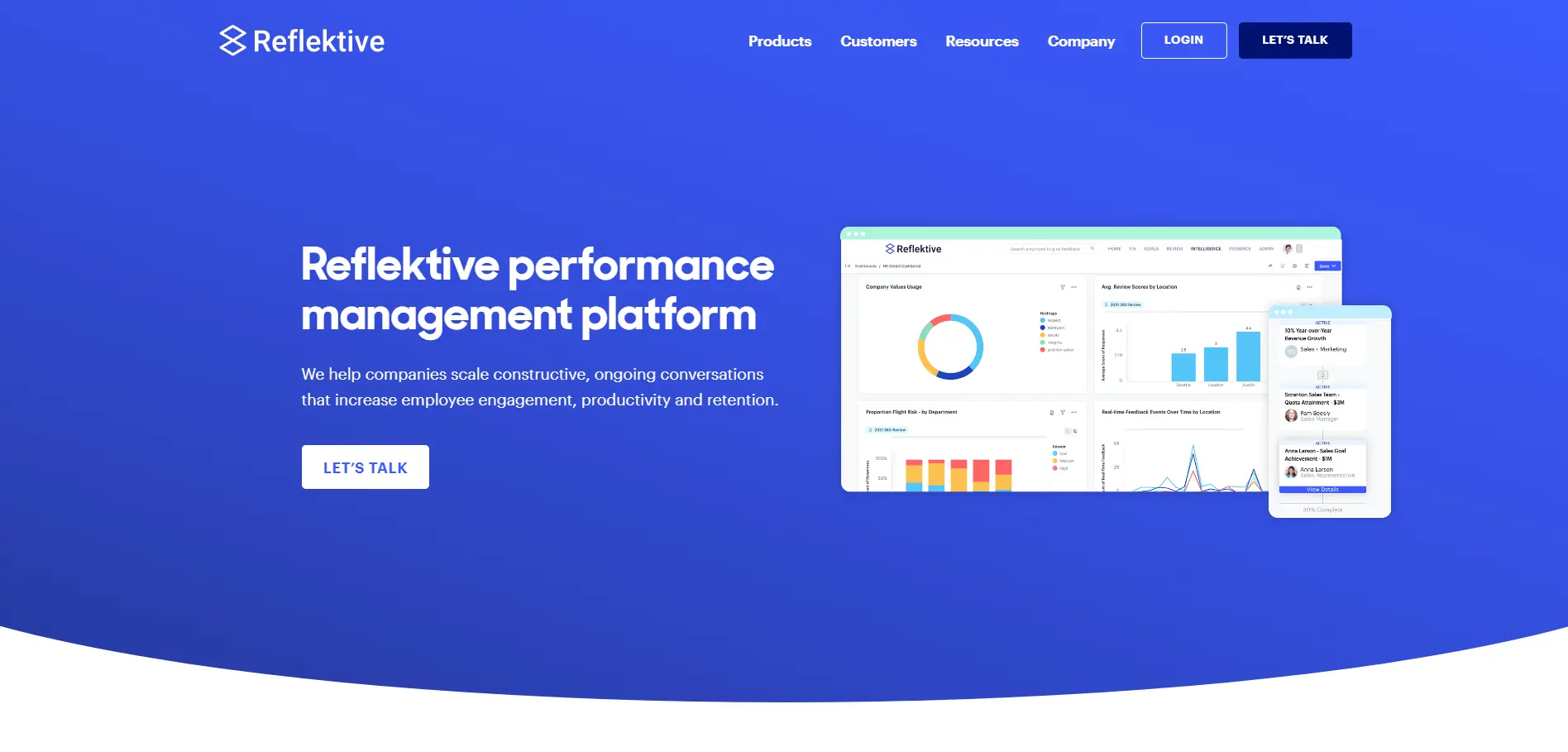
Reflektive is a holistic performance management platform that expands talent management capabilities. The platform enhances engagement and analytic tools to foster constructive conversations between colleagues. With features like public recognition, surveys, benchmarks, and action plans, Reflektive enables business leaders to improve employee engagement and optimize performance. The platform integrates with HRIS systems and provides pre-built dashboards for easy insights and trend analysis.
Contact Reflektive for pricing details.

Bamboo HR is an HR and hiring software program designed for small and medium-sized businesses. Along with tracking applicants throughout the hiring process, Bamboo HR assists organizations in organizing and utilizing employee information throughout the entire employee lifecycle. The software offers data and analytics, hiring support, onboarding features, compensation management, and tools for creating a positive company culture.
Contact Bamboo HR for pricing details.

Synergita is a comprehensive performance management, employee engagement, and learning platform designed to enhance organizational efficiency. It empowers businesses to foster professional development, align teams with a shared mission, boost employee engagement, streamline performance optimization, and automate critical processes.
Synergita’s basic plan starts from ₹ 80 per user/ month and for more information Contact their sales team

Leapsome is an all-in-one performance management, employee management, and learning platform. It enables businesses to provide professional development opportunities, align employees around a central mission, increase engagement, optimize performance, and automate processes. Leapsome integrates with popular HR and management systems and provides customer success managers, implementation support, and training resources.
Contact Leapsome for pricing details.
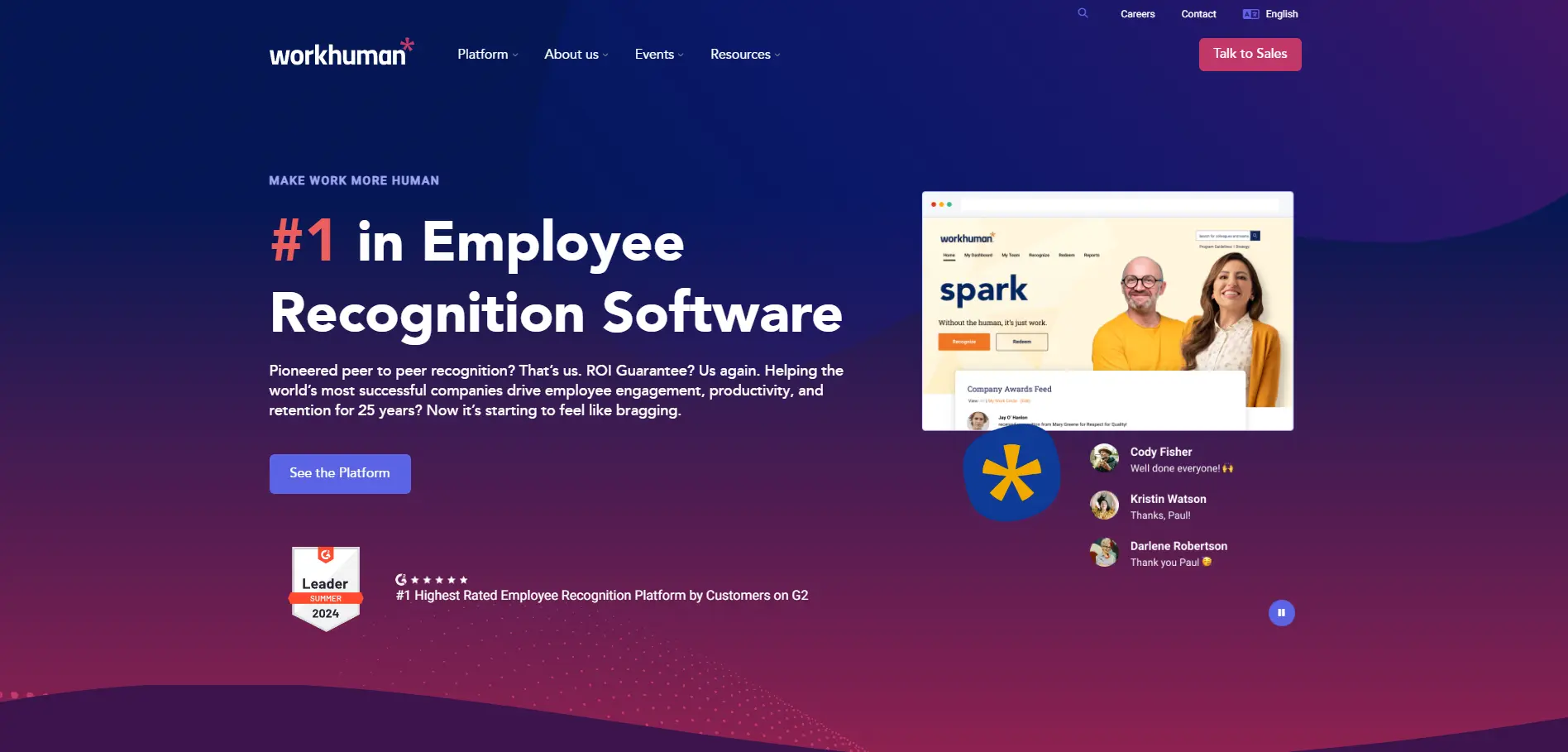
Workhuman Conversations is a performance development software integrated with Social Recognition. The tool simplifies the documentation of employee feedback, progress, and performance reviews. It enables users to request and receive feedback from anyone at any time, providing managers with valuable insights and a holistic view of their employees. With Workhuman Conversations, users can initiate check-ins, create agenda items, and share progress updates on the app and any device.
Contact Workhuman sales team for pricing details.
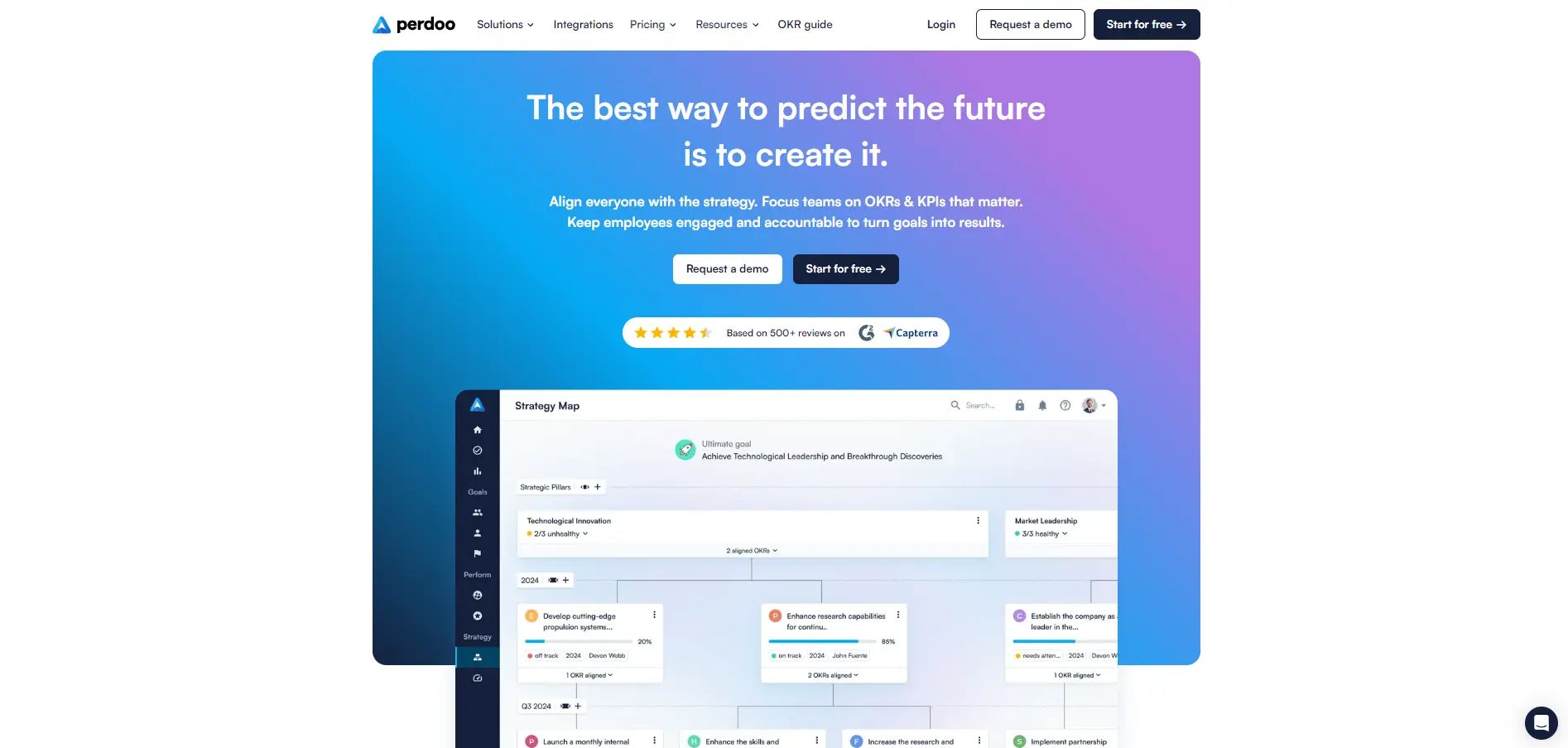
Perdoo is a performance management platform designed to help organizations align their goals and objectives, drive employee engagement, and enhance overall business performance. Trusted by a diverse range of companies, Perdoo provides a comprehensive suite of features to facilitate goal setting, tracking progress, and fostering a culture of continuous improvement.
Perdoo’s basic plan starts from €9 per user/month and for more information Contact Perdoo Sales Team.

PerformYard is a simple yet powerful performance management software designed to streamline annual reviews, establish quarterly goals, and provide consistent feedback to employees. The platform offers features such as reviews and check-ins, 360 reviews, goal management, continuous feedback, and reporting. PerformYard ensures performance management is easy for both supervisors and employees.
PerformYard’s basic plan starts from 1$ – 3$ per user/month and for more information contact their Sales team.
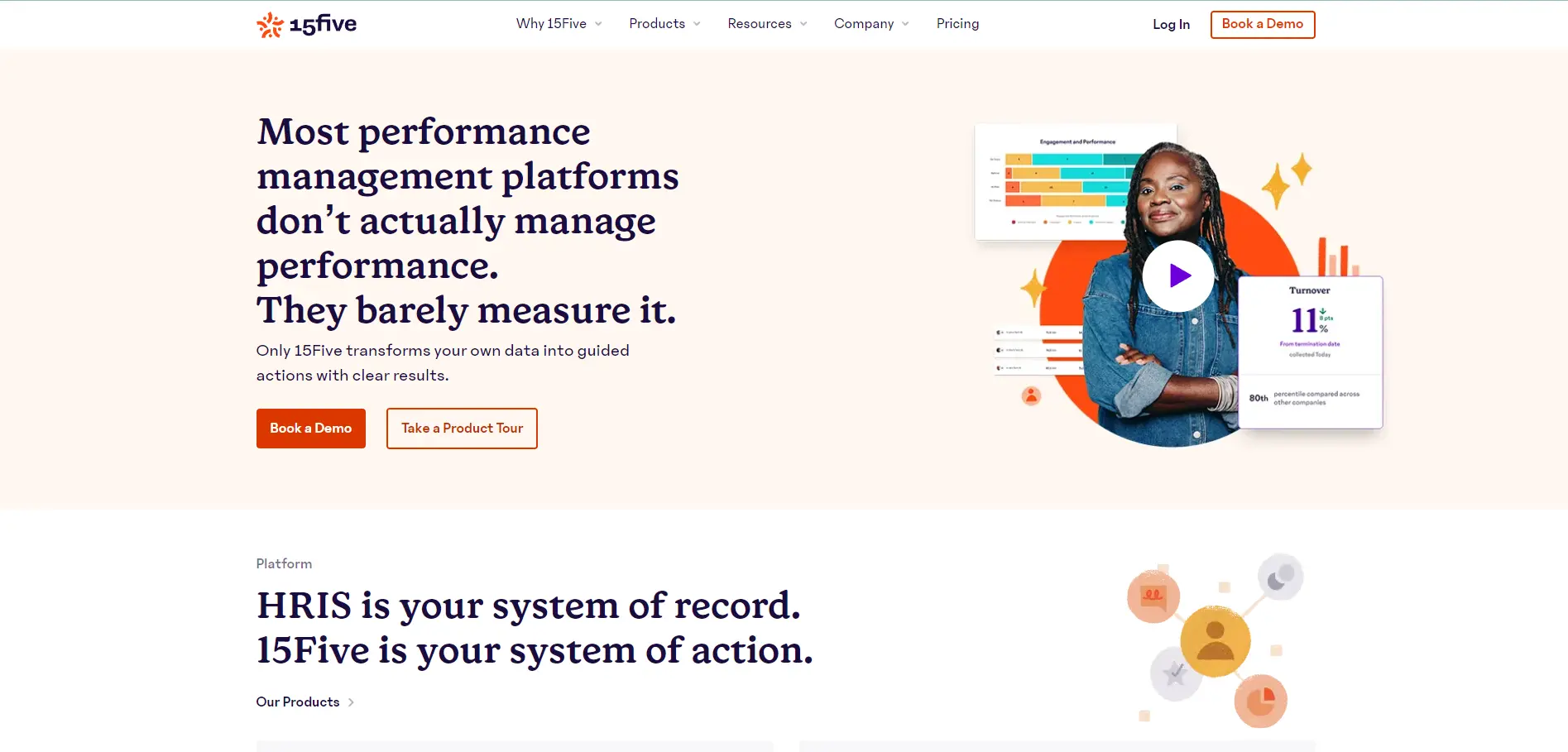
15Five is a performance management platform focused on creating effective managers, engaged employees, and high-performing organizations. The platform enables leaders to transform engagement insights into tangible results, communicate and track objectives and key results (OKRs), and optimize performance. 15Five offers features such as engagement assessments, performance reviews, role clarity, strength discovery, OKRs and goals, real-time feedback, employee recognition, manager training, a coaching hub, and integrations.
15Five basic plan starts from 4$ per user/month and for more information Contact 15Five Sales Team
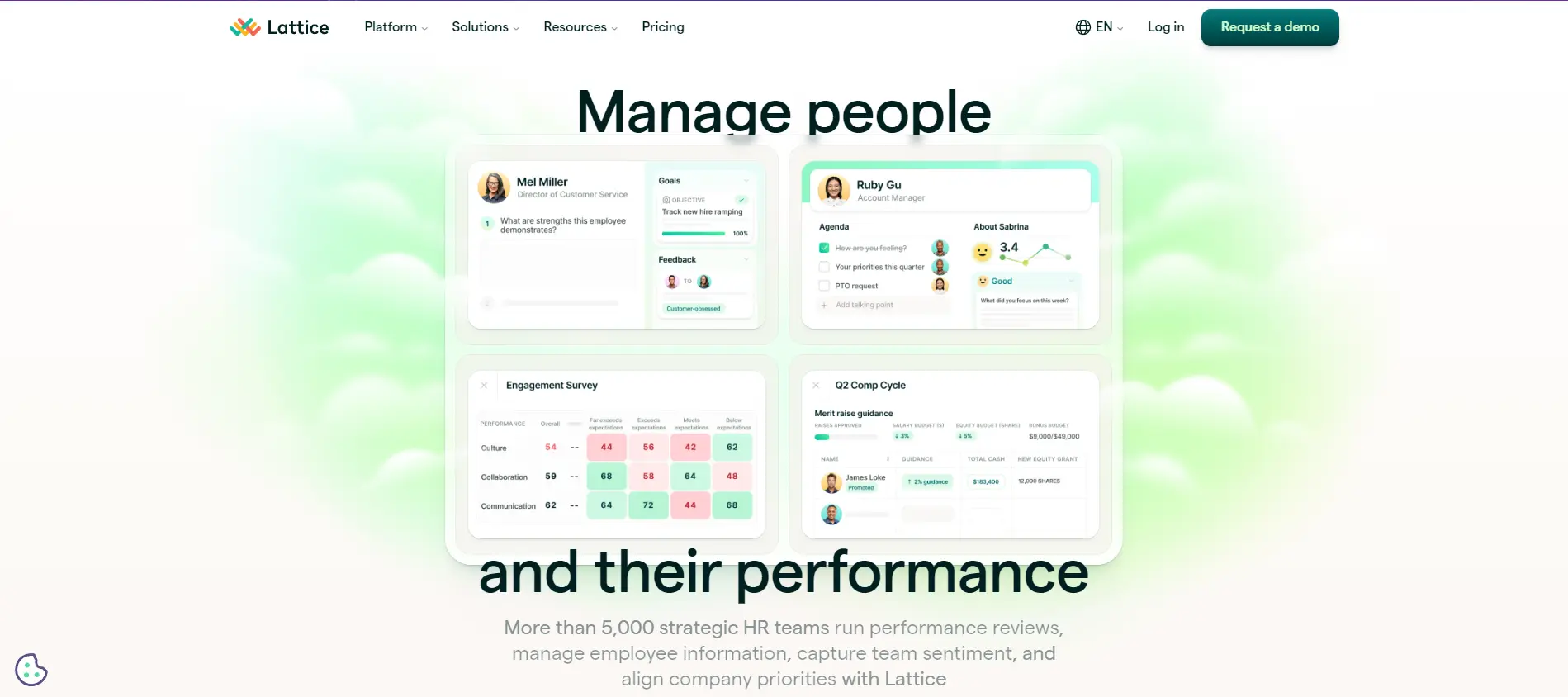
Lattice is a cloud-based performance management platform that helps companies connect performance to business goals. It offers tools to help you set goals, track progress, and measure the impact of your performance management efforts. Lattice is used by some of the world’s most innovative companies, including Google, Airbnb, and Netflix.
Lattice basic plan starts from 4$ per user/month and for more information, Contact Lattice Sales Team

Culture Amp is a platform that helps companies measure and improve employee engagement. It offers surveys, analytics, and reporting tools to help you track your progress. Culture Amp is a good option for large companies that are looking to improve their employee engagement and culture.
Contact CultureAmp sales team for more information.

Trakstar is a cloud-based talent development platform that helps businesses streamline and automate their HR processes, from recruitment and onboarding to performance management and continuous learning. With its comprehensive suite of tools and features, Trakstar empowers organizations to build, engage, and retain a high-performing workforce.
Contact Trakstar sales team for more information.

AssessTEAM is a multilingual, cloud-based employee performance management software. It allows supervisors to evaluate on-the-job performance, deliver timely input to teams, analyze project productivity and profitability in real-time, and manage a customizable time-tracking system. AssessTEAM is user-friendly, secure, and accessible on mobile devices.
AssessTEAM basic plan starts from ₹216 and for more information contact their sales team.

ClearCompany is a talent management, HR, and applicant tracking system designed to improve hiring, onboarding, performance, and engagement. The platform helps businesses onboard new hires, provide actionable feedback, stay compliant with HR requirements, review and manage employee performance, engage employees, and make smart decisions in any economic environment. ClearCompany offers a comprehensive set of features to streamline HR processes and optimize performance management.
Contact ClearCompany for pricing details.
In today’s dynamic business landscape, fostering a high-performing and engaged workforce is no longer a luxury but a necessity for organizations seeking to thrive and succeed. At Datalligence, we understand the critical role that performance management plays in driving organizational success.
Our AI-driven performance management platform, coupled with a comprehensive array of features, empowers businesses to unlock the full potential of their workforce.
At Datalligence, we are committed to providing a user-friendly and intuitive platform that simplifies the process of setting, monitoring, and achieving your goals. Our team of subject matter experts is dedicated to guiding you through the implementation process, ensuring a seamless transition and maximizing the impact of our solution on your organization’s performance and employee engagement.
Embrace the future of performance management and unlock the full potential of your workforce with Datalligence. Contact us today to schedule a personalized consultation and discover how our cutting-edge solutions can drive transformative change within your organization
Editor2025-07-08T09:26:43+00:00July 7, 2025|Performance Management|
Did you know that only 10% of U.S. workers feel
Editor2025-06-19T12:32:42+00:00June 18, 2025|OKR Examples|
Manufacturing industries are process-oriented and driven by high-quality standards.
Editor2025-06-01T13:07:08+00:00May 25, 2025|Objectives and Key Results|
Organizations continuously seek effective best performance management tools to optimize
Editor2025-05-23T13:05:57+00:00May 21, 2025|Performance Management|
Maintaining productivity in the fast-paced business world of the
Editor2025-05-13T09:04:38+00:00May 12, 2025|Objectives and Key Results|
Why do you need OKRs?We all have great goals and
Editor2025-05-02T09:13:30+00:00April 22, 2025|Objectives and Key Results|
Introduction to OKRsObjectives and Key Results (OKRs) are one of
Editor2025-04-06T12:19:53+00:00April 1, 2025|Objectives and Key Results|
Financial reporting plays a crucial role in business management
Editor2025-04-04T05:58:44+00:00March 31, 2025|Objectives and Key Results|
OKR Benefits Translated for Remote Performance Management Objectives and
Editor2025-04-04T03:11:01+00:00March 30, 2025|Objectives and Key Results|
OKRs have been the talk of the town. The pandemic
Editor2025-04-01T05:49:52+00:00March 29, 2025|Objectives and Key Results|
Objectives and Key results, or OKRs, have become one of
Objectives and Key results, or OKRs, have become one of the most preferred frameworks for most organizations. OKRs can be an important tool for dynamic teams that plans and measure their success.
Objective defines “what” has to be done and Key results help us understand “how” we need to achieve the objective. These OKRs help us to be aspirational and inspirational. As per the Harvard Business Review OKRs are the most effective goal-setting tool for the teams.
OKRs are designed to be interconnected, making it essential to establish them across the entire organization. While individuals set their own OKRs for personal development, most should align with and contribute to the organization’s overall goals.
The organization’s OKRs help in setting the baseline for the expected business outcomes. Further from here, individual departments derive their OKRs and then cascade further to their teams and then to individual team members. While these are being derived, it is extremely important to have team OKRs. This brings in team strength and shared responsibility. Also, certain organizational OKRs bear better results when set as team OKRs.

Team OKRs are those which help the organization in translating the goals to results. If the goal set for the team is right and is also aligned to the right company objective, it gives the key stakeholders visibility of how the objective is progressing. As OKRs have a shorter cadence, we can constantly review and add the right inputs that are required for the growth.
Team OKRs bring the team together, motivate them to work effectively, and enhance focus and accountability. Peer-to-peer motivation and working toward shared goals create an engaging and rewarding journey.
While setting up OKRs, the primary focus should be on growth. OKR software makes it easy to align and monitor OKRs constantly. It could be as an individual or as a team or a company, but remember that these three growths may not be achieved in one hit. While setting up objectives, you need to ask yourself these questions;
• Are we doing something new?
• Are we doing something different?
• Are we doing a significant amount of work than before?
After having set the OKRs, it then moves further to monitoring how and by when we achieve them. Monitoring plays a major part in setting the OKRs. While monitoring happens after having set the OKRs, the key factors that determine how well the OKRs are set are the monitoring mechanism, periodicity, and the outcome measurement.
There have to be clear and concise OKRs derived for Team OKRs because this impacts the overall team’s performance. A checklist is useful to govern the process.
Are the goals of departments/individuals connected with the company’s goals?
• Are key results (metrics) directly linked to priorities?
• Does everyone on the team have three priorities or less?
• Are all objectives agreed upon and clearly defined?
• Are all employees aware of their metrics and understand them?
To briefly look at the history, approach for organizational management OKR was introduced the first time in Intel. From 1999, when Google started to use it, many companies in different fields and scales such as LinkedIn, GE, Salesforce, Netflix, GoPro, Facebook, Amazon, Walmart, Target, The Guardian, Dun and Bradstreet, and ING Bank also implemented it.
These are big names and established organizations, a few of them conglomerates, which have been successful in setting OKRs and course-correcting wherever necessary. Using OKR Software makes organizations agile and transparent and helps course-correcting easily. It has to be noticed that OKRs are neither confined to a particular industry nor the size of an organization. It is an enabler in itself at any given point and a strong tool to moderate and accelerate business growth and profits.
Feel free to browse our products session to have a glimpse of what we offer.
Reach out to us at https://datalligence.ai or write to us at cs@datalligence.ai to implement OKR based performance management.